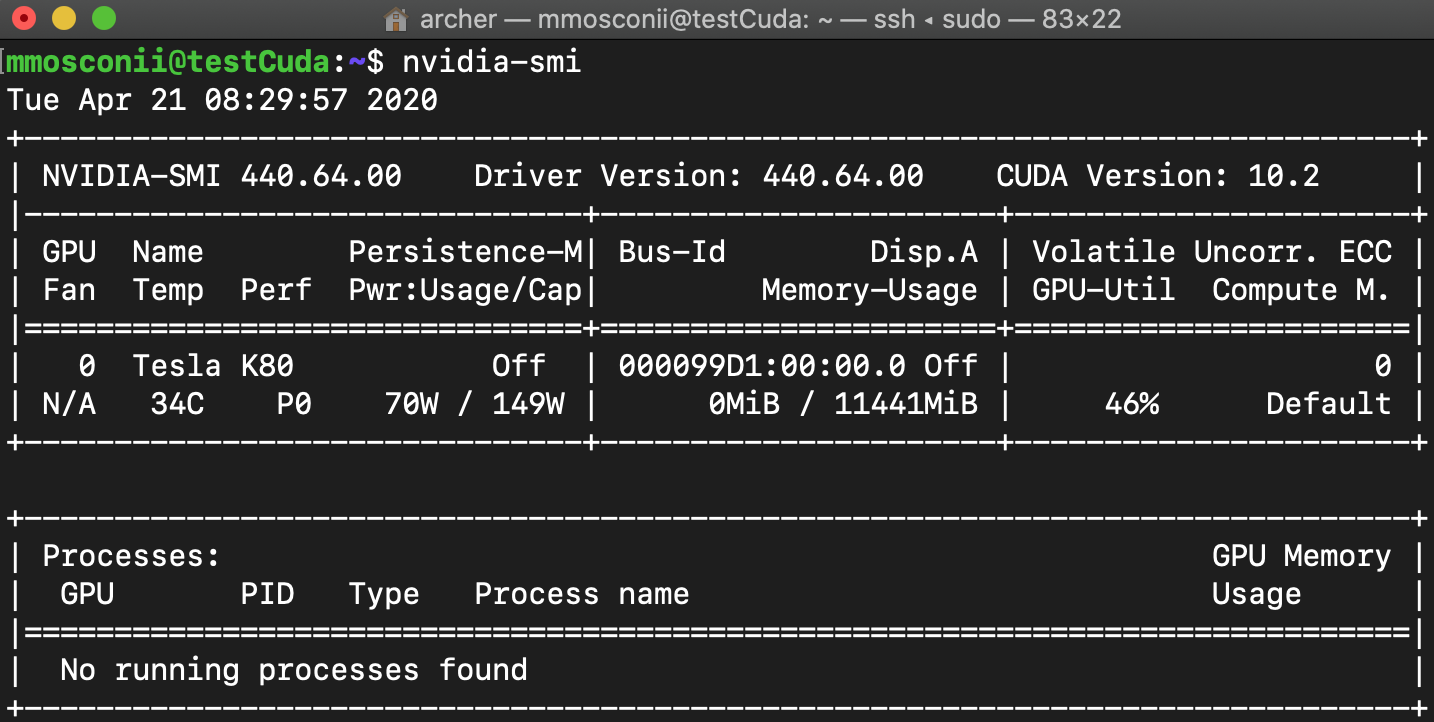
- #UBUNTU INSTALL NVIDIA CUDA TOOLKIT HOW TO#
- #UBUNTU INSTALL NVIDIA CUDA TOOLKIT DRIVERS#
- #UBUNTU INSTALL NVIDIA CUDA TOOLKIT UPDATE#
- #UBUNTU INSTALL NVIDIA CUDA TOOLKIT ARCHIVE#
- #UBUNTU INSTALL NVIDIA CUDA TOOLKIT DOWNLOAD#
Initialize Numpy Arrays with Tuple Unpacking Technique – np.random.rand and np.
#UBUNTU INSTALL NVIDIA CUDA TOOLKIT HOW TO#


#UBUNTU INSTALL NVIDIA CUDA TOOLKIT ARCHIVE#
Sudo dpkg -i cuda-repo-ubuntu-local-ga2_8.0.61-1_bĭpkg: error processing archive cuda-repo-ubuntu-local-ga2_8.0.61-1_b (–install):Ĭannot access archive: No such file or directoryĮrrors were encountered while processing:Ĭuda-repo-ubuntu-local-ga2_8.0.61-1_b In the past few months, I have been looking for a way to install the Nvidia container toolkit on an arbitrary Ubuntu 20.04 instance host. Linux-headers-4.10.0-38-generic set to manually installed.Ġ upgraded, 0 newly installed, 0 to remove and 38 not upgraded. Sudo apt-get install linux-headers-$(uname -r) I prefer installing CUDA from a runfile on Ubuntu 18.04 since it is hard to encounter dependency issues.
#UBUNTU INSTALL NVIDIA CUDA TOOLKIT DOWNLOAD#
Depending on your installation method of choice, you need to download equivalent package. I’ve downloaded the kernel packages via this line: Once this has been installed, you can proceed to install Nvidia CUDA toolkit. If the pip3 command does not exist, run sudo apt install python3-pip command to install it.Īs the project page mentioned, users have to run the following 2 commands one by one to prevent Ubuntu’s own gpu-manager from interfering: sudo prime-select on-demand sudo systemctl disable rviceĢ.) Next, run command to make sure you have the agent packages installed for installing Gnome Extensions: sudo apt install chrome-gnome-shell gnome-shell-extension-prefsģ.I’m following your steps but I’m running into an error when installing via debian package I’m new to Ubuntu so might be making some obvious mistakes. Navigate to the source folder, and install it for global use via pip package manager: cd envycontrol & sudo pip3 install.Use git command to grab the source: git clone.Press Ctrl+Alt+T on keyboard to open terminal, and run the command below one by one: To make it easy to switch between your GPUs, there’s a Gnome Extension available to add options into system tray menu.ġ.) To get the menu option, you need to first install the open-source Env圜ontrol tool.

And, change the line of ‘Exec’ to: Exec=env _NV_PRIME_RENDER_OFFLOAD=1 _GLX_VENDOR_LIBRARY_NAME=nvidia supertuxkart Add System Menu option to Switch CPU desktop file which is usually under “/user/share/applications” directory. For example, launch SuperTuxkart (a kart racing game) via command: _NV_PRIME_RENDER_OFFLOAD=1 _GLX_VENDOR_LIBRARY_NAME=nvidia supertuxkart You can do this by launching apps from command line. Then there’ll be application-specific menu to tell it which device to use.Ģ.) For other apps, just use the following environment variables. Run certain apps via NVIDIA GPU while rendering desktop via integrated graphicsīy setting GPU mode to “NVIDIA On-Demand”, you may run certain apps via NVIDIA GPU, while others handled by the integrated GPU.ġ.) For CUDA apps, you need to run command in terminal (Ctrl+Alt+T) to install the nvidia-cuda-toolkit package. As a workaround, choose Intel graphics card by running sudo prime-select intel in terminal.Ĭhanging GPU mode however needs log out and back in to apply changes. In my case, the “Intel (Power Saving Mode)” is somehow grayed out. Intel (Power Saving Mode) – use integrated graphics to render Ubuntu desktop.NVIDIA On-Demand – use integrated graphics to render desktop, but possible to offload specific apps via dedicated GPU.NVIDIA (Performance Mode) – use dedicated NVIDIA GPU to render Ubuntu desktop.Then you’ll see three options available in the right: When the app opens, navigate to ‘ PRIME Profiles‘. To switch GPU mode, search for and open ‘ NVIDIA X Server Settings‘. When done, restart your computer! Switch between NVIDIA and Intel Graphics:Īfter restart, your machine will be on performance mode with the dedicated GPU. There will be a little bar indicates the installing process.
#UBUNTU INSTALL NVIDIA CUDA TOOLKIT DRIVERS#
Then re-launch the ‘Software & Updates’ utility.Ĭhoose one of the drivers from the list and click on ‘ Apply Changes‘ to install it.
#UBUNTU INSTALL NVIDIA CUDA TOOLKIT UPDATE#
If it shows nothing, press Ctrl+Alt+T to open terminal and run command sudo apt update to refresh package cache. There it should list all available graphics drivers. Make sure ‘restricted’ repository enabledĢ.) Next, navigate to ‘ Additional Drivers‘ tab.


 0 kommentar(er)
0 kommentar(er)
